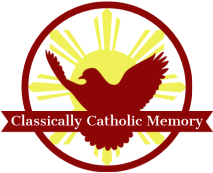Using Classically Catholic Memory at Home or in a Co-op
Classically Catholic Memory (CCM) can be used either at home by an individual family, or in a co-op setting with a number of families. The same material (which is clearly laid out) will be used in either setting, but the general format for presenting and scheduling the material will probably be different.
At Home
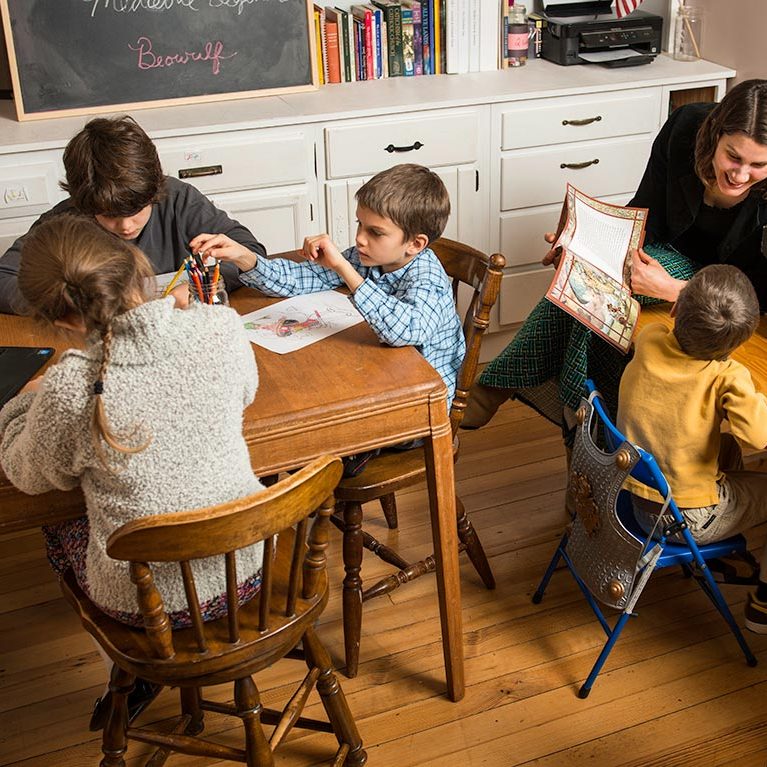
At Home you have many options for presenting the material at home. You might plan to present all of the new memory work in one block of time, such as every other Monday morning from 9-11 a.m. (Remember, you can plan to allow two weeks for each “week” of the memory work, which will spread the memory work for one CCM “year” over a 36-week school year). Many homeschoolers schedule art or music (Schola Rosa has art and music that is complementary to CCM) in this way; you can do the same with memory work in order to keep things simple. If you schedule it in one block of time, two hours is a good estimate for the amount of time it will take. This will allow a full thirty minutes for Science with its related activities (given in the Teacher Text); about 15 minutes each for History, Math, Timeline, and Geography; and ten minutes each for Latin, Religion, and Great Words.
After the new material has been presented (on Monday, for instance) you will probably want to schedule about 20 minutes on the following days for practice and review of the memory work. “Memory work” then becomes its own subject just like math or spelling. In our family, our initial presentation of the new memory work happens at our every-other-Friday co-op; however, we follow up with about 20 minutes a day of practicing the material at home, just as you would if you were using the material solely at home. We also play the CD frequently as we are driving in the car, and this, combined with the daily review of the material, seems to be enough to enable the children to master it in about two weeks.
You might also consider the possibility of presenting the new material for the week as the child begins that subject each week, rather than taking one large block of time to present all subjects. For example, if your child begins his week’s work on Monday morning with math, you could take a few minutes right then to present the new math memory work. Then the child would continue with his regular math lesson. If the child does history on Tuesday afternoons, then on Tuesday afternoon you would begin with the history memory work for that week, and the child would then continue with his regular history work. Of course, you might have to shorten the amount of “regular” work he is doing that day since presenting and beginning to practice the memory work will take up extra time. On the following days you would spend time reviewing the memory work material whenever the child is working on that subject in his “regular” homeschool work. However, if a particular subject is not usually done daily (such as history or science, for example), then you will just need to build this into a daily schedule, making sure that all of the memory work is reviewed daily.
You also have the option of planning the History and Science memory work so that the introduction of each memory work topic matches perfectly with your “regular” history and science curriculum. For example, there are 18 general topics in history; one history sentence is devoted to each topic (each “sentence” is really a short paragraph of two or three sentences giving detailed information about that topic). You could look through your planned history curriculum to see in which weeks those topics are covered, and then cover the CCM History sentence for that topic during that particular week. This might mean changing the order, somewhat, of the CCM history sentences; you could simply write down the actual order you’ll be using in the front of your Teacher Text, or make notes to yourself on the weekly summary sheets. Or, you could mark in your history curriculum when to introduce a particular CCM history sentence.
I do not think that making the CCM History and Science “match” your other curricula perfectly is necessary, so do not feel that you have to go to that trouble. For two years, our family has used CCM (Alpha and Beta years) without trying to make the weeks when we cover certain topics (in CCM and our “other” history curriculum) line up perfectly. I think there is actually a benefit to not having them match perfectly. If you get to a certain topic in your regular history curriculum a few weeks before you reach the CCM History sentence about it, that’s fine; the CCM History sentence will be a great review and “cementing” of the basic facts. If, on the other hand, you cover the CCM History sentence a month before you cover that topic in your history curriculum, then great—they will already know the basic facts and will be ready to dive in more deeply!
Sample Teacher Text Page
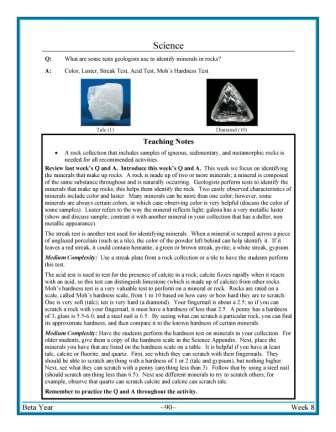
Sample Teacher Text Page
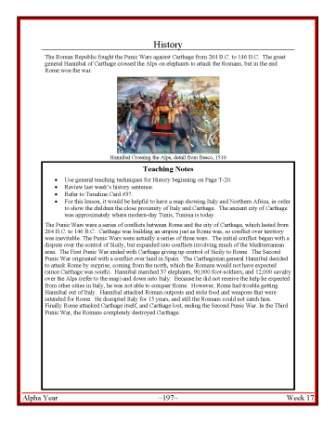
Student Presentation

In a Co-op
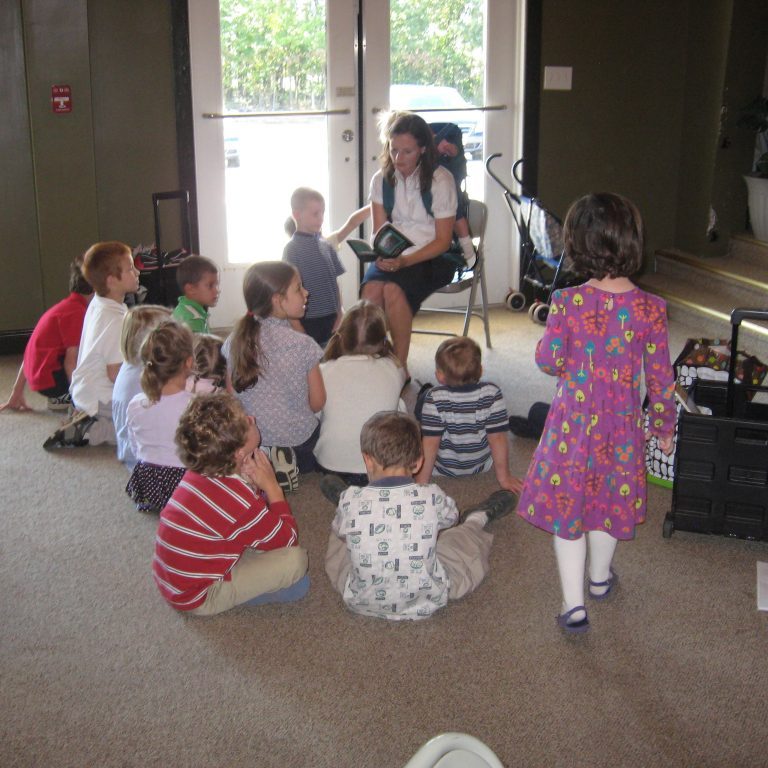
In a Co-op there are many benefits to using Classically Catholic Memory in a co-op setting, not the least of which is increased motivation (on the part of the students and the parents!) to master the material. It is also a lot of fun! We have used CCM in a co-op setting for two years, and my children love co-op. Somehow, just doing the memory work in a classroom with seven or eight friends of the same age makes it “fun”!
Having a number of children in the program allows more variety in the kinds of activities that can be done to help the students practice the material. I’ve described many of the activities that can work well in a co-op in the Teacher Text from each year, but I’ll give one example of an activity that we did frequently in our co-op. For timeline, rather than simply having individual students put timeline cards in the correct order, in my class in co-op we put ourselves in order. I gave out a timeline card to each student to hold, and chose another student to put everyone in the correct order. Seven- and eight-year-olds can have a lot of fun with this! They would lead their friends by the hand to the “right” place in line, spin some around, and then move them again until they thought everyone was correctly placed. Then, we had “judges” decide if the order was correct or not, and if not, what had to change. It is easier to do activities like this in a large group, rather than with just one or two students.
We also added certain elements to our co-op that are not part of the official CCM material. For instance, we added a public speaking element to give the children practice in speaking in front of a group. Every week, every student gives some sort of presentation to their class. The presentation can be on any number of possible topics, but needs to be “educational”. Students have shared poems they have written, brief reports on books they have read, information on history topics that they have learned about at home, and even things like information on the various dog breeds or the positions of soccer players in a soccer game.
Fine Arts is another subject that we have added to our CCM co-op that provides variety in our morning. Every week that we meet, the children spend 30 minutes on either art or music; the art combines art history and actual art projects related to the time period the children are studying in history, while music focuses on becoming familiar with famous composers. I’ve included more suggestions in the Teacher Text on how to add this component to the CCM program.
One of the most significant parts of our co-op mornings has been coming together at the beginning of the day for prayer and a religious presentation. Every family takes a turn leading the opening prayer and then doing a presentation for the entire co-op on some aspect of our Catholic faith. These family-led prayers and presentations have been a tremendous blessing to our group. They help to remind us of our focus: learning to know and love God more deeply. They help us to see CCM as part of this goal. They also greatly increase group cohesiveness and help in forming deeper bonds with one another. Topics have included the lives of various saints, the canonization process for saints, Lenten practices, other seasons and feasts of the liturgical year, Marian apparitions, the Brown Scapular, the choirs of angels, Gregorian chant, the feast of Divine Mercy, and more. Even very young children in the families participate, sometimes by holding up pictures they have drawn related to the topic. Older children share information about the topic according to their age, as do the moms. Occasionally, even a few dads come to participate with the rest of their family.
To give an idea of the amount of time that might be allotted to the various subjects and activities in a CCM co-op, here is the schedule we have followed:
Sample Schedule
8:40: Gather in the parish hall. Announcements are made. One family leads the prayer and does a family presentation (10 minutes). We then go over Religion and Latin together in the large group setting. The parent who teaches the Religion component reviews last week’s material and presents the new week’s material, and the children practice it several times (5 minutes). The parent who teaches Latin follows a similar format (5 minutes). We then recite the Pledge of Allegiance together.
9:00: We break into age groups: 5- to 6-year-olds, 7- to 8-year-olds, 9- to 10-year-olds, and 11- to 12-year-olds, and head into the classrooms. We also have a four year old class which is doing a Catholic preschool program unrelated to CCM, and an older group of 13-14 year olds who spend half the morning moving quickly through the CCM material, and the other half of the morning working on writing projects and literature discussions. The church allows us to use their nursery, so the mothers who do not have a teaching role head to the nursery with the children who are 3 and younger.
All classes might then work on the subjects in a different order, but here is a schedule that one class might follow. For every subject, the basic format is to briefly review the last week’s material in that subject, then present and practice the new week’s material while doing any appropriate activities to teach and to reinforce the material (suggested activities to teach each subject are given in the Teacher Text).
9:00-9:15: Math
9:15-9:30: Timeline
9:30-10:00: Science (outdoors if possible)
10:00-10:15: Snack, while half the students do their weekly presentation
10:15-10:30: Geography
10:30-11:00: Fine Arts
11:00-11:10: Great Words
11:10-11:30: History
11:30-11:45: Student presentations (half of the class)
11:45-12:00: All classes come together again in the Hall and pray the Angelus.
12:00-12:30: Mass, for those who choose to stay; others depart.
12:30-2:00: Lunch outside on the picnic tables and social time by the playscape.
During one of our years, we also allowed extra time at the end of one co-op session mid-year and at the last session of the year for presentations by the children and for competitions in the various subjects. For presentations, children could present any of the CCM material that they had mastered and wanted to share with all of us. Some recited a poem from that year’s material, others said a prayer in Latin, and a few recited the timeline. We then had competitions in history, science, and geography; children could choose one subject to participate in and earned points for correct answers (or, in the case of history, for being able to recite a history sentence when prompted with the first few words). All of this was a great review of the material and very motivating for the children. At the end of the year, all of the children were given certificates congratulating them on their work in our Classically Catholic Memory co-op.
After a co-op session, during which the new material for the week is introduced and practiced, we allow about 20 minutes a day at home to review and work on mastering the material for that week. We also play the CD frequently. Using this schedule, the children generally have mastered the material by our next co-op day, which is two weeks later.
What do you need to do to form a co-op?
First, pick someone to be the leader. This person will be in charge of scheduling dates to meet, acting as the liaison to the church (or other facility) where you are meeting, communicating with the group about weekly schedules, signing up families to do the weekly prayer/presentation, coordinating the flow of classes, and generally recruiting moms to help in all of the roles that are needed. The leader may also be in charge of bringing in necessary supplies for math or science activities, or she can find a volunteer to be in charge of supplies. If every parent tries to contribute something to the co-op, things work smoothly. Secondly, find a place to meet, ideally, of course, at a local Catholic church. Third, decide what roles you need filled, based on the size of your group.
If you have a small group, you might have only two main age groups; if larger, up to four. You will need a parent to teach each age group, several to help with younger siblings, and someone to teach Latin and religion (or split this up among two people, each taking one subject). If you are going to do fine arts, it could be integrated into the regular classes, and the regular teacher could teach it, or one parent could be the designated fine arts teacher and the different age groups could rotate into the fine arts class. It is nice for the regular teachers to have a “break” at some point in the morning, and having only one person handle fine arts means that that person can concentrate totally on art and also handle the clean-up (while the class heads back to their regular room and continues with their memory work). If you have a lot of younger siblings, you might also consider doing a preschool class for three and four year olds; if you have older siblings, perhaps one mom can plan something for that group.
If your co-op plans to do some of the more complex science activities during the year (suggested science activities for each week, related to that week’s science material, are described in detail in the Teacher Text) it might also be helpful to have one adult in charge of science. That person can be in charge of planning for the activities, purchasing supplies, and running a “science station” that the different age groups rotate through, just as they might with fine arts. Having a “science station” can help things run smoothly and efficiently when specific supplies need to be shared among classes, or when a fair amount of preparation is needed.
Co-ops can be large (ours has 18 families and about 50 participating children, not counting younger siblings!) or small (just two or three families working on the material together). Either way, they are a great chance to come together with other Catholic homeschoolers and motivate each other to master the CCM material, while having fun.
For a great FREE resource for starting a co-op, check out Schola Rosa's "Recruit" page.
